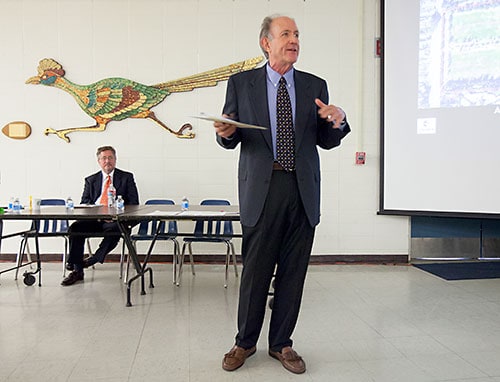Forum yields information, questions on La Puerta site

On June 9, Claremont Lincoln University placed a winning bid of $14.35 million on a 9.7-acre piece of property belonging to the Claremont Unified School District. The potential purchase has raised questions and eyebrows, given the parcel’s significant community impact.
The land, former site of the district’s La Puerta Intermediate School, is bound on the west side by the nine-acre La Puerta Sports Park. The park’s playing fields, which the city has long leased from the district, are popular sites for youth soccer and softball games. The remaining three sides of the parcel face residential neighborhoods.
Sports park users and neighbors gathered in the multi-purpose room of Chaparral Elementary School on July 23, hoping to learn more about the plans Claremont Lincoln University (CLU) has for La Puerta.
There were many concerns. Would the park be closed to the public during construction or even indefinitely? Would the CLU buildings block the view of the mountains or attract large amounts of traffic?
Representatives of CLU, most notably the school’s president Eileen Aranda, were on hand at the meeting to take questions and listen to feedback. Other attendees included district luminaries Superintendent Jim Elsasser and CUSD Board Member Hilary LaConte, as well as town officials like Mayor Corey Calaycay and City Manger Tony Ramos.
The guest shedding the most light on CLU’s plans was architect John E. Sather, who works for Swaback Partners, Inc., the architectural firm employed by the school.
First, he let it be known that, while the site would serve as the Claremont Lincoln University campus, won’t have the impact of a traditional campus.
CLU students hailing from across the globe engage in the school’s curriculum, which emphasizes ethical leadership and inter-denominational cooperation, via online courses.
A couple of times a year, however, students will gather at their home campus, in a small auditorium seating 500 or less students. There will be administrative offices, but the average number of daily visitors will be small.
Mr. Sather then went on to deliver two principal messages. The first was one of limitless possibility. Swaback Partners is known for architecturally and environmentally innovative projects. They’re also known for taking the concerns and ideas of the people who live near their building sites very seriously. By working together, the architect said, CLU and residents have the opportunity to shepherd in a building project the city would be proud of 100 years from now.
His second message was a more restrictive one. The sale is in escrow and the buyer can back out if the terms of the purchase prove unsuitable.
This proved to be the case when Brandywine Homes bought the La Puerta site in November of 2013 for $19 million. The homebuilding company backed out of the deal a few months later when the city failed to approve the number of units the company had hoped to build on the site.
CLU will aim for low-density and low-visual impact, Mr. Sather said. It’s his hope the school will reflect its surroundings. For instance, while he can’t promise there will be no three-story buildings on the site, it is his preference to keep things to one or two stories.
But the school does want to change the landscape a bit by moving the sports park so it’s on the east side of the property on Forbes Avenue, rather than on Indian Hill Boulevard. The move would require approval by the CUSD board and city council.
The swap would be beneficial to both Claremont Lincoln and residents, Mr. Sather said. The university would gather needed exposure by being located on Indian Hill, and Forbes Avenue residents will find the park to be a nice buffer between the area’s homes and the university.
Should the change-up be approved, the park would be rebuilt at Claremont Lincoln’s expense, according to Mr. Sather. And the creation of a new park would be tackled before campus construction, ensuring as much continuity as possible among park users.
School officials are eager for the sale to go through, because they need the proceeds for many pressing capital projects. City officials seem likewise disposed to green light the park rotation.
The general consensus seems to be that CLU’s plans are a better fit for the neighborhood than Brandywine’s housing development would have been. Still, several Forbe’s Avenue homeowners worry they would lose privacy due to the placement of a park. Another concern was that stadium lights would cause light pollution.
Another homeowner said he could stand to lose his view of the local mountains should a CLU structure rise too high.
Mr. Sather noted that technology has changed significantly since the old La Puerta stadium lights were put in and that there are ways to ensure that lights are directed onto the fields, while not overpowering surrounding areas.
He also noted that he wants the community to welcome the project. He made a blanket offer to go to anyone’s house and stand in their yard to get the resident’s perspective.
If the park can’t be flipped with the school, it might just be a deal breaker, Mr. Sather admitted. Beyond that, however, nothing about the facilities CLU hope to build is set in stone.
His philosophy, and that of Swaback Partners, is that community concerns and ideas should be heard before a project is begun. When asked about his plans for construction, he said none have been drawn up. After all, he pointed out, it would be “disingenuous” of him to seek community input when he has already formed his vision.
This is just the first of many community meetings that will precede the creation of any concrete planning for the La Puerta site, according to Mr. Sather.
To get a taste of the many residential, commercial and institutional projects undertaken by Swaback Partners, visit www.swabackpartners.com/index.html.
—Sarah Torribio
storribio@claremont-courier.com











0 Comments